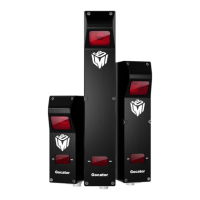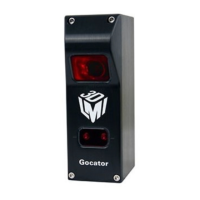Gocator Line Profile Sensors: User Manual
Gocator Web Interface • 443
Gocator exposure and output activates depends on the processing latency. The latency is reported in
the dashboard and in the health messages.
8. Specify a delay.
The delay specifies the time or spatial location between the start of Gocator exposure and the output
becomes active. The delay should be larger than the time needed to process the data inside the
Gocator. It should be set to a value that is larger than the processing latency reported in the dashboard
and in the health messages.
The unit of the delay is configured in the trigger panel. See Triggers on page 117 for details.
The analog output takes about 75 us to reach 90% of the target value for a maximum change, then
another ~40 us to settle completely.
To respond to software scheduled commands:
1. Go to the Output page.
2. Click on Analog in the Output panel.
3. Set Trigger Event to Software.
4. Specify if the output is immediate or scheduled.
An analog output value becomes active immediately or scheduled. Immediate output becomes active
as soon as a Scheduled Analog Output command (see Schedule Analog Output on page 597) is received.
Software scheduled command can schedule an analog value to output at a specified future time or
encoder value, or changes its state immediately. The Delay setting in the panel is ignored. Commands
that schedule event in the past will be ignored. An encoder value is in future if the value will be reached
by moving in the forward direction (the direction that encoder calibration was performed in).
Serial Output
Gocator's web interface can be used to select measurements to be transmitted via RS-485 serial output.
Each sensor has one serial output channel.
Two protocols are supported: ASCII Protocol and Selcom Serial Protocol.
Gocator 2500 series sensors do not support the Selcom Serial Protocol.
The ASCII protocol outputs data asynchronously using a single serial port. For information on the ASCII
Protocol parameters and data formats, see ASCIIProtocol on page 652.
The Selcom Serial Protocol outputs synchronized serial data using two serial ports. For information on
the Selcom serial protocol and data formats, see Selcom Protocol on page 663.
For information on wiring serial output to an external device, see Serial Output on page 771.
